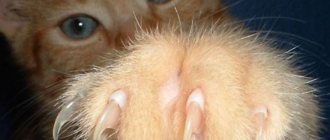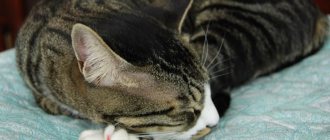When a kitten appears in the house, many questions arise. What to feed the baby? How to train to a tray? Where to arrange a sleeping place? At what age can kittens be bathed? It is so important to keep the animal's fur clean. Previously, the cat's mother was watching over this, and he himself had not yet learned how to perform hygiene.
The kitten will remember the first contact with water for a long time, so you need to take the process seriously.
If your pet still has negative emotions, then next time he will fight back hard: scratching, biting and struggling with all his might. That's why you need to turn bathing not only useful, but also a pleasant pastime.
Some breeders claim that a kitten can be washed from the age of one month. This is explained by the fact that such a baby practically does not resist and does not scratch. But it’s not worth risking the baby’s psyche, because any unknown procedure is a great stress for him.
Do cats need to be bathed?
There is an opinion that cats are extremely clean animals, so they do not need bathing at all. Like, if a purr does not sleep, does not eat or does not play, he licks himself and puts his fur in order. This is partly true; healthy cats are always concerned with their own hygiene. But washing animals living in the house, or, especially, on the street, is mandatory.
IMPORTANT: Environmental conditions today have changed a lot. Not only people, but also their pets suffer from harmful environmental factors. Bad air, polluted water and synthetic food have a bad effect on the condition of the skin and coat of cats. One way to care for them is bathing.
A domestic cat is bathed once every 3 months.
You should definitely bathe your cat if:
- He is a stray or taken home from the street if he lives in the courtyard of a private house, goes outside for a walk every day or during the “wedding season”. If a cat returns from being outside dirty, with matted fur, water treatments are equally necessary for him and his owners. He will recover quite well on his own. But is it necessary for all this dirt to get into the animal’s gastrointestinal tract? And while it rests, traces of dirty paws will remain in the house on the floor and on the furniture. Contact with a walking cat until it is washed is contraindicated for a child living in the house.
- If he gets dirty. A cat that has gotten into something sticky, inedible or toxic needs to be bathed immediately, before it begins to lick itself.
- If he sheds. During the molting period, cats lick themselves many times more often and more intensely; with their tongue they collect fallen hairs from their fur coat. These hairs clog the stomach, and if they are not regurgitated, they cause the animal to experience discomfort and problems with stool, and refuse to eat. Representatives of long-haired breeds may even experience intestinal obstruction. If you buy a shedding cat, it will be easier for him.
- If his undercoat is too dense. In this case, the cat cannot wash itself thoroughly.
- His fur gets too greasy. This happens due to the peculiarities of the functioning of the sebaceous glands or due to illness.
- He got fleas. You will need to bathe with a special anti-parasitic shampoo.
- He is hairless. Hairless cats must be bathed once a week. By the way, many sphinxes and similar cats love to swim.
Hairless cats are bathed once every 1-2 weeks.
IMPORTANT: Bathing is a mandatory procedure for a cat participating in an exhibition or competition.
What to do next?
After bathing, the kitten is wrapped in a towel to absorb excess moisture. After a few minutes, the wet towel should be changed. There is no need to rub the little body, just blot it
. Next, the wool is dried with a hairdryer, otherwise it will roll up and tangles will remain. In addition, a child who has not reached adulthood can catch a cold and get sick, because even in a warm room, the wool will dry completely only after 10–12 hours.
The scary buzzing device is kept at a distance of 30 cm from the cat. If it is possible to adjust the air supply, then it is better to choose a gentle mode.
At the end, the fur coat is combed out with a brush and the kitten is sure to be offered a favorite treat so that washing is associated with pleasant emotions.
Bathing cats needs to be taken seriously. To avoid problems with age, it is better to accustom the kitten to washing before the age of one year.
, since an adult animal will desperately resist. By the way, for such alarmists they came up with dry shampoo that does not require contact with water. If necessary, you can bathe the baby completely, but not earlier than 2 weeks after birth. Still, it is better to postpone the procedure until the cat reaches 2–3 months of age.
Bathing your pets is an important part of caring for them. For some this process is easy, but for others it is very difficult and involves the manifestation of violent emotions. How to bathe a kitten to minimize its fear of water?
An interesting fact is that a kitten’s first bath can determine his entire attitude towards this procedure. If you bathe your pet for the first time with the utmost care and caution, the kitten will love the water. But if you make a lot of mistakes, you can forget about calmly bathing your cat. After an incorrect water procedure, the pet may even be afraid of the sounds of water from the tap.
Washing the cat cannot be neglected in the future, even if he wears flea collars and special products. Therefore, it is in the owner’s interests for the cat to love water from childhood.
Pet owners who often take part in exhibitions are advised to start water treatments from one month.
But if only you and your loved ones admire your kitten, it is better to wait a little and tame it to water from three to five months. At this age, bathing will be less stressful for your pet.
You shouldn’t put it off either, as it will be harder for him to get used to it later. If you urgently need to bathe a kitten when it is only a month old, you need to carry out the procedure very carefully. It is important to monitor the water temperature and avoid hypothermia.
If your baby has been vaccinated, you need to wait 14 days before washing. After castration, water procedures cannot be performed for 10 days.
How often can you wash your cat and at what temperature?
Has anyone ever wondered why cats are afraid of water? How justified is their fear? For animals, everything is much simpler; they are not subject to groundless panic. The fear of water in cats is due to the following:
- After swimming, they are at risk of hypothermia or overheating. The air cushion formed between the skin and fur of the cat warms it. After bathing, it disappears, the animal freezes. Also, the coat, naturally moistened with sebum, protects the cat from the scorching rays of the sun. A washed pet loses this protection.
- There is a risk of infection. The cat's sebaceous glands produce a secretion with antibacterial properties. During bathing, it is washed away, leaving the animal defenseless against bacteria, fungi, and other infections.
- Wet wool smells. Cats are by nature nocturnal animals and hunters. They have strong camouflage instincts. Purrs carefully bury feces behind them and carefully lick their fur coat so as not to emit odors. Washed cat fur smells very strongly, and this makes the cat very worried.
Bathing is stressful for a cat.
IMPORTANT: Bathing a cat is a necessary procedure, but you cannot overdo it. Frequent water treatments can harm your pet.
Therefore, you need to know how often to wash your cat. Veterinarians recommend:
- regularly once every 2-3 months, if the animal is healthy
- more often as needed and after consultation with a specialist
IMPORTANT: A cat’s body temperature is higher than that of a human and is 38-39 degrees. The most comfortable water for bathing an animal will be water at approximately the same temperature, but not lower than 37 degrees.
At what age can a kitten be washed?
You should start bathing procedures 2 or 3 weeks after the kitten appears in your family. This is the time required for its complete adaptation to new living conditions.
Bathed after several months
It is much easier to wash a baby than an adult cat, because he practically does not resist. To better cleanse the skin and coat, use hypoallergenic pet shampoos with a balanced pH. At the same time, the bathing product should be made specifically for representatives of the cat family because, for example, some shampoos that are safe for dogs are often toxic for cats.
Pchelodar Shampoo with beebread and keratin
Price: 344 rub.
467 rub.
26% discount for you!
Helps activate blood circulation. Fast delivery throughout Russia. And also more than 3,000 other pet products at competitive prices! Take a look!
How and when to wash a kitten for the first time and with what?
Unless there are any special circumstances, a mother cat successfully cares for her babies, including their fur. In the first month from birth, healthy kittens do not need bathing.
You need to wash your kitten for the first time at the age of 3-4 months.
IMPORTANT: Veterinarians advise giving a kitten a bath for the first time at the age of 3-4 months.
It is not recommended to bathe younger kittens because:
- baby may get scared
- if he's with his mom, she might not recognize him as smelling like shampoo
- The baby has not yet established thermoregulation, he may freeze and get sick
IMPORTANT: Kittens that have been vaccinated should not be bathed for 10-14 days.
So, the decision was made to wash the kitten. What's the best way to do this?
- The procedure should be carried out 2 hours after feeding the kitten.
- It is necessary to prepare the bathing area so that cat shampoo and two terry towels are at hand. How to choose a shampoo can be read below.
- It is better to bathe a kitten not in the bathtub, but in the sink and basin. Lay a terry towel or cotton sheet on the bottom.
- Approximately 5 cm of water is collected in a sink or basin. Her temperature is measured. 38 degrees is the optimal indicator.
- It is better to turn off the tap while bathing the kitten; the noise of the water may frighten it. You can wash off the shampoo with a ladle or a mug. If the wool is dense, it can only be washed with running water; the stream from the tap or shower should not be under high pressure.
- The kitten should not be immersed in water abruptly, starting with its hind legs. At the same time, it is important to stroke him and calm him down.
- Perhaps, like a child, a kitten will tolerate bathing more easily if it has balls and toys - squeakers - that will distract it from the unpleasant procedure.
- You need to water the kitten's body very carefully, making sure that water does not get into the eyes and ears. The shampoo should be rinsed off the fur thoroughly.
- After bathing, the baby should be wrapped in a towel to prevent him from freezing. When the towel gets wet, it should be replaced.
- Dry the kitten's fur with a soft brush or hairdryer if he is not afraid of it.
To calm your kitten while bathing, you need to talk to him. Your pet's favorite toy will also help.
IMPORTANT: The success of subsequent baths largely depends on the kitten’s first bath. If it went smoothly, the adult animal will treat the procedure calmly and indifferently. If the baby has experienced stress, in the bath he will be a real demon, which will be difficult to cope with even together.
Stages of successful hygiene
It is advisable for one person to hold the animal and the other to wash it. The first rule when bathing your baby is in warm, but not hot, water. Its temperature should not exceed 38⁰ C
. It is better to close the bathroom door tightly. A long-haired kitten must be combed first to untangle the clumps. Items you should prepare in advance:
- basin;
- ladle;
- warm water in a saucepan;
- hypoallergenic shampoo for kittens;
- 2–3 towels;
- cotton swabs for ears;
- cotton pads;
- reward treat.
Small cotton balls are used to plug the baby's ears to prevent water and detergent from getting into them. So much water is filled into the basin so that its level reaches the kitten’s neck. Calming the pet with quiet words, gently moisten the fur with a sponge or hand. For the first time, you should not immediately put the animal in the basin, otherwise it may frighten it.
After the coat is well moistened, shake a little shampoo in your palm and distribute evenly over the body, paws and tail, rubbing lightly. They don't soap their hair. Excess foam is removed with your hands, and the baby is slowly placed in the basin. To wash off the detergent, pour the body from a ladle, scooping clean water from a saucepan. You can do this with a shower if the kitten is not scared. Finally, wet cotton pads are used to wipe the eyes, nose and outer part of the ears.
Subsequent baths can begin by lowering a cat aged 5 months or more into a basin or sink filled with water. But this should be done correctly: slowly dip the hind and front legs, and then the body.
How to wash a cat if she is afraid of water?
It is important that water does not get into your cat's ears while bathing.
It is advisable to bathe an adult cat that is afraid of water and struggles to get out of the bath together.
- Fill the bath with water at a level of 10-15 cm, depending on the size of the cat.
- The water is turned off.
- The animal is carefully lowered into the water, its fur is wetted with a sponge, very carefully. Never immerse a cat in water with its head.
- The shampoo is diluted with water according to the proportion indicated on the package. They lather the animal's fur with it.
- Remove the shampoo immediately or after some time, scraping off the foam with a brush, watering the animal from a ladle or shower under thin streams.
- Like a kitten, dry and warm the cat with a towel. Change it when it gets wet. It is advisable to dry an animal with long hair with a hairdryer with warm air.
- If after bathing the cat decides to retire and lick itself, there is no need to disturb it.
After bathing, the cat needs to be warmed and dried.
IMPORTANT: To make bathing a cat comfortable, you need to take into account not only the temperature of the water in the bath, but also the air temperature in the room. It should not be below 15 degrees Celsius, otherwise the pet may get pneumonia.
Features of bathing sphinx kittens
The recommendations given in this section apply to all three breeds of Sphynx - Don, Canadian and Peterbald. They will also be relevant for other hairless cats or animals with sparse fur. For example, for Cornish and Devon Rex.
Cats without hair have a number of characteristics that affect the bathing procedure. The fat layer, which in ordinary animals serves as protection, in sphinxes only contaminates the surface of the animal’s body, so such kittens need to be bathed more often (in the cold season - two or three times a month, in the summer - every week).
Sphynxes have very delicate and unprotected skin, so you should not wear gloves when bathing these cats. It is best to use shampoos that are designed specifically for this breed. If for some reason this is not possible, a product for short-haired cats is also suitable. But it will need to be diluted with water in advance.
Sphinxes do not wash their heads, but rather wipe them after bathing. To do this, use a cotton pad moistened with water. Particular attention should be paid to the skin behind the ears, areas in the corners of the eyes and near the nose.
You can dry sphinxes only with a towel, and never use a hairdryer. The fabric used to wipe such cats must be soft and fluffy. The movements when wiping must be smooth and light, without strong pressure.
For this breed of cat, keeping the room warm after bathing is very important. Experts recommend keeping a washed Sphynx in a room with a temperature of at least 25 degrees. You can even put a special overall and a hat on the animal so that it does not catch a cold.
The British have an instinct for cleanliness at the genetic level. But in order to achieve lasting and positive results in the behavior of these pets, it is very important to raise them correctly. In this article we will tell you what is needed to keep a British cat in an apartment, how to train him to use a litter box, and also how to wash and comb British cats. By following the basic rules of caring for the mustachioed inhabitant of the house, you will raise a truly luxurious animal with the manners of an aristocrat.
Tar soap for fleas in cats: how to use?
Tar soap based on birch tar contains natural substances that have disinfestant properties. It is believed that it can remove fleas from cats.
Tar soap is used against fleas on cats.
IMPORTANT: Yes, tar soap against fleas helps, but the procedure will have to be carried out several times, perhaps a lot. The soap solution washes out or kills fleas, but not their eggs. Frequent bathing is harmful for cats; it is preferable to use modern means that get rid of fleas in 1-2 applications.
If you still decide to remove fleas from a cat with tar soap, it is done like this:
- Prepare a soap solution. 0.25 soap is grated and completely dissolved in 200 ml of warm water.
- Moisten the cat's fur with regular warm water.
- Treat the wool with a solution of tar soap so that it gets on the skin. Thoroughly wash the folds of the paws, under the tail, neck and withers.
- Keep the animal in a soap solution for 5-10 minutes.
- Carefully wash off the tar soap from the cat's fur.
- Repeat the procedure every 2 weeks as necessary (it is in 2 weeks that flea eggs hatch).
IMPORTANT: Even after thorough rinsing, a specific smell of tar soap remains on the animal’s fur, which can cause discomfort to the animal. If a cat does not respond well to the procedure for removing fleas with tar soap, it is better not to repeat it and choose another product.
What to wash with?
Shampoo for kittens is different from shampoo for humans. This is due to differences in acid-base balance. Regular shampoo can also damage your pet's fur and skin.
If the kitten is a little dirty, you can wipe the stain with a damp cloth.
There are several types of special shampoos:
- Liquid shampoo
can be used on small kittens and adult cats. With it you can achieve silky and soft wool. It should be used in small quantities, as it will be difficult to wash off a lot of foam. - Dry shampoo
is a salvation for panic fear of water. It is applied to the skin, then combed from the fur along with the dirt. Dry shampoo can be used more often than usual, as it does not upset the oil balance and does not lead to dry skin. Allowed for use from three months of age. Before applying it to your pet, you need to make sure that the skin is completely dry. - Spray shampoo
should be applied to wet fur. You can use it from the age of six months, because it has a distinct smell.
Kittens do not need to be washed with adult cat shampoo. Small pets have more delicate skin, so they are at risk of getting dermatitis.
How and what to bathe a British cat?
British cats have plush fur with a thick undercoat. She needs special care, which, in addition to good nutrition, taking vitamins, regular brushing, includes bathing once every 2-3 months.
British cats need bathing.
A British man is given a bath. The fact is that it will be difficult to wash out all the shampoo from his undercoat in a sink or basin. If a cat is afraid of the sound of water when washing it out of a ladle or mug, you need to comb it out at the same time with a special brush.
Shampoo for short-haired cats.
For bathing, you should get a special shampoo for the British breed.
When it's snowing and cold outside
photo from the site: VashiPitomcy.ru
Now about whether it is possible to bathe a cat in winter and how to do it. You shouldn’t completely forget about bath procedures, but it is necessary to reduce their number. That is, we don’t let the animal become covered in dirt, but we also don’t wash it more than once every four months.
At normal temperatures in the apartment, it is enough to wipe the animal dry by wrapping it in a towel. To speed up drying, you can turn on a hairdryer. The main requirement for winter swimming is no drafts.
Is it possible to bathe a cat in the heat?
If a cat suffers from the heat in the apartment in the summer, the owners may want to give it a bath to refresh it. But frequent bathing, as is already known, can be harmful. Therefore, “refreshing procedures” are recommended to be carried out as follows:
- place a wet towel within reach of the animal so that it can lie on it or wet its paws
- spray the cat with water from a spray bottle
- wipe the cat's head and paws with a damp cloth
And even in these cases, the water should not be very cold so that the cat does not catch a cold.
Bathing rules
After water procedures, the pet should be dried with a towel and the fur combed.
Instructions:
- Prepare everything you need: a place, shampoo, drying products, nail clippers, a hair brush.
- To wash the kitten, use a sink, bowl or bathtub. A rubber mat is placed in the container so that the animal can hold on to it with its claws. Set the shower to medium pressure, add some water (temperature up to 40 degrees).
- Before bathing, we trim the cat’s claws to avoid unpleasant situations and scratches. We do this carefully so as not to damage our fingers. It is worth cutting off a small part, not the entire claw.
- Gently lower it into the water.
- If your pet is scared and refuses to take a bath, try talking to him or picking him up by the scruff of the neck. This calms and subdues him. Cats sense the emotion with which they are addressed, so speak softly and calmly.
- Give your pet a chance to explore the tub before bathing. This way the cat will get used to it and won’t be scared. Hold it lightly to avoid escape.
- Wet the fur - first the back, then the sides, tail, paws, belly, chest and neck. There is no need to wash your hair, make sure that the liquid does not get into the eyes and ears.
- Lather with a little shampoo (use animal shampoo).
- Wash it off.
- Wrap in a towel and wipe. Since wool is dense, you can use a hair dryer to dry the fur quickly. It needs to be turned on in advance so as not to scare you.
- Use a dry cotton pad to wipe the animal's eyes and ears. If water gets in there, try to get rid of it.
- Brush your pet according to the growth of its fur.
Is it possible to bathe a cat during heat?
You can bathe a cat during a difficult period of estrus; the procedure will not harm her. Moreover, some owners have noticed that after bathing their pets are so busy licking that they even calm down for a while. But this does not mean that water procedures can be performed every day. They resort to them only once.
Bathing during heat distracts the cat.
Should I bathe a kitten after vaccination and castration?
After vaccination, the kitten cannot be bathed for at least 2 weeks, because during this period the animal’s immunity will be reduced by the vaccine. But the kitten should be bathed after a scheduled worming, when worm eggs may end up on the fur and need to be washed off. And deworming is done just before vaccination, so before you vaccinate the kitten, you can give it a bath.
After castration and sterilization, at least 10 days must pass before swimming, because... During this period, the sutures heal.
It’s also not worth bathing a kitten in the first days after you take it home. The animal is experiencing terrible stress, which you will only intensify, as a result of which its immunity will drop. The exception is yard cats, which, of course, need to be washed immediately.
Also watch a video on how to bathe a kitten.
Probably everyone knows that cats do not like to swim; water procedures are a lot of stress for them. Most owners do not wash their pets, but there are those who bathe their cats regularly - monthly, and even weekly.
If the cat is clean and does not go outside, then you don’t have to wash it; it will take care of its own toilet - it will diligently put itself in order every day. But it happens that situations arise when the cat simply needs to be washed.
You need to prepare for the first bathing procedure in advance, because how it goes will determine the animal’s attitude towards washing in the future. Bathing can be a pleasant experience for your cat if you follow some simple rules.
And some more tips on washing cats
- Do not bathe a pregnant cat or if she is nursing kittens.
- An adult, unneutered cat needs more frequent washing. Due to the secretion secreted, his fur gets dirty faster, becomes greasy and sticks together.
- At least two weeks must pass after the operation, and only then can the animal be bathed.
- If you adopted a pet from a shelter, you should not wash it in the first few days. Moving and swimming together is incredibly stressful.
- During the shedding period, washing helps to quickly get rid of dead hairs.
- Do not wash your animal while it is sick.
So, the frequency of bathing is a conditional indicator. It depends on the cat’s cleanliness, the characteristics of its lifestyle and conditions of detention. An attentive owner will always understand that his pet needs additional care and will carry out water procedures with maximum comfort.











